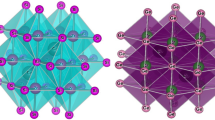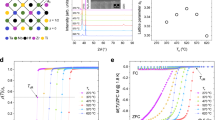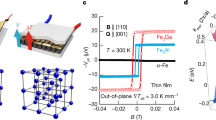Abstract
Thermoelectric materials transform a thermal gradient into electricity. The efficiency of this process relies on three material-dependent parameters: the Seebeck coefficient, the electrical resistivity and the thermal conductivity, summarized in the thermoelectric figure of merit. A large figure of merit is beneficial for potential applications such as thermoelectric generators. Here we report the thermal and electronic properties of thin-film Heusler alloys based on Fe2V0.8W0.2Al prepared by magnetron sputtering. Density functional theory calculations suggest that the thin films are metastable states, and measurements of the power factor—the ratio of the Seebeck coefficient squared divided by the electrical resistivity—suggest a high intrinsic figure of merit for these thin films. This may arise from a large differential density of states at the Fermi level and a Weyl-like electron dispersion close to the Fermi level, which indicates a high mobility of charge carriers owing to linear crossing in the electronic bands.
This is a preview of subscription content, access via your institution
Access options
Access Nature and 54 other Nature Portfolio journals
Get Nature+, our best-value online-access subscription
$29.99 / 30 days
cancel any time
Subscribe to this journal
Receive 51 print issues and online access
$199.00 per year
only $3.90 per issue
Buy this article
- Purchase on Springer Link
- Instant access to full article PDF
Prices may be subject to local taxes which are calculated during checkout




Similar content being viewed by others
Data availability
The data that support the findings of this study are available from the corresponding author upon reasonable request.
Code availability
The computer codes that support the findings of this study are available from the corresponding author upon reasonable request.
References
Cahill, D. G., Watson, S. K. & Pohl, R. O. Lower limit to the thermal conductivity of disordered crystals. Phys. Rev. B 46, 6131–6140 (1992).
Dresselhaus, M. et al. New directions for low-dimensional thermoelectric materials. Adv. Mater. 19, 1043–1053 (2007).
Koumoto, K. & Mori, T. (eds) Thermoelectric Nanomaterials (Springer, 2013).
Graf, T., Felser, C. & Parkin, S. S. Simple rules for the understanding of Heusler compounds. Prog. Solid State Chem. 39, 1–50 (2011).
Felser, C. & Hirohata, A. (eds) Heusler Alloys: Properties, Growth, Applications (Springer, 2016).
Knapp, I. et al. Impurity band effects on transport and thermoelectric properties of Fe2−xNixVAl. Phys. Rev. B 96, 045204 (2017).
Venkatasubramanian, R., Siivola, E., Colpitts, T. & O’Quinn, B. Thin-film thermoelectric devices with high room-temperature figures of merit. Nature 413, 597–602 (2001).
Zhao, L.-D. et al. Ultralow thermal conductivity and high thermoelectric figure of merit in SnSe crystals. Nature 508, 373–377 (2014).
Zhang, H. & Talapin, D. V. Thermoelectric tin selenide: the beauty of simplicity. Angew. Chem. 53, 9126–9127 (2014).
Tan, G. et al. Non-equilibrium processing leads to record high thermoelectric figure of merit in PbTe–SrTe. Nat. Commun. 7, 12167 (2016).
Mori, T. Novel principles and nanostructuring methods for enhanced thermoelectrics. Small 13, 1702013 (2017).
Chen, Y.-T. & Tan, Y. The optical, magnetic, and electrical characteristics of Fe2Si thin films. J. Alloys Compd. 615, 946–949 (2014).
Tang, C. P., Tam, K. V., Xiong, S. J., Cao, J. & Zhang, X. The structure and electronic properties of hexagonal Fe2Si. AIP Adv. 6, 065317 (2016).
Yordanov, P. et al. Perovskite substrates boost the thermopower of cobaltate thin films at high temperatures. Appl. Phys. Lett. 110, 253101 (2017).
Wong, D. High power factor Ge-Sb-Te thermoelectric thin film: an evidence of temperature-induced band convergence. In 37th Int. Conference on Thermoelectrics (ICT, 2018).
Cha, J., Zhou, C., Cho, S.-P., Park, S. H. & Chung, I. Ultrahigh power factor and electron mobility in n-type Bi2Te3–x%Cu stabilized under excess Te condition. ACS Appl. Mater. Interfaces 11, 30999–31008 (2019).
Hazama, H. et al. Improvement of power factor of n-type Bi2Te3 by dispersed nanosized Ga2Te3 precipitates. J. Alloys Compd. 726, 578–586 (2017).
Baba, T., Taketoshi, N. & Yagi, T. Development of ultrafast laser flash methods for measuring thermophysical properties of thin films and boundary thermal resistances. Jpn. J. Appl. Phys. 50, 11RA01 (2011).
Baba, T. Analysis of one-dimensional heat diffusion after light pulse heating by the response function method. Jpn. J. Appl. Phys. 48, 05EB04 (2009).
Hinterleitner, B. et al. Stoichiometric and off-stoichiometric full Heusler Fe2V1-xWxAl thermoelectric systems. Preprint at https://arxiv.org/abs/1801.08966 (2018).
Petsagkourakis, I. et al. Thermoelectric materials and applications for energy harvesting power generation. Sci. Technol. Adv. Mater. 19, 836–862 (2018).
Burkov, A. A., Hook, M. D. & Balents, L. Topological nodal semimetals. Phys. Rev. B 84, 235126 (2011).
Li, R. et al. Dirac node lines in pure alkali earth metals. Phys. Rev. Lett. 117, 096401 (2016).
Lv, B. Q. et al. Experimental discovery of Weyl semimetal TaAs. Phys. Rev. X 5, 031013 (2015).
Weng, H., Fang, C., Fang, Z., Bernevig, B. A. & Dai, X. Weyl semimetal phase in noncentrosymmetric transition-metal monophosphides. Phys. Rev. X 5, 011029 (2015).
Xu, N., Xu, Y. & Zhu, J. Topological insulators for thermoelectrics. npj Quant. Mater. 2, 51 (2017).
Tang, Y. et al. Convergence of multi-valley bands as the electronic origin of high thermoelectric performance in CoSb3 skutterudites. Nat. Mater. 14, 1223–1228 (2015).
Zeier, W. G. et al. Thinking like a chemist: intuition in thermoelectric materials. Angew. Chem. 55, 6826–6841 (2016).
Zhang, J. et al. Discovery of high-performance low-cost n-type Mg3Sb2-based thermoelectric materials with multi-valley conduction bands. Nat. Commun. 8, 13901 (2017).
Baba, T. et al. Research and development of metrological standards for thermophysical properties of solids in the National Metrology Institute of Japan. High Temp. High Press. 39, 279–306 (2010).
Yagi, T., Taketoshi, N. & Baba, T. Development of thin film reference material for thermal diffusivity. In Proc. 1st Int. Symposium on Thermal Design and Thermophysical Property for Electronics (NMIJ/AIST, 2008).
Hohenberg, P. & Kohn, W. Inhomogeneous electron gas. Phys. Rev. 136, B864–B871 (1964).
Kohn, W. & Sham, L. J. Self-consistent equations including exchange and correlation effects. Phys. Rev. 140, A1133–A1138 (1965).
Kresse, G. & Hafner, J. Ab initio molecular dynamics for liquid metals. Phys. Rev. B 47, 558–561 (1993).
Kresse, G. & Hafner, J. Ab initio molecular-dynamics simulation of the liquid-metal–amorphous-semiconductor transition in germanium. Phys. Rev. B 49, 14251–14269 (1994).
Kresse, G. & Furthmüller, J. Efficient iterative schemes for ab initio total-energy calculations using a plane-wave basis set. Phys. Rev. B 54, 11169–11186 (1996).
Blöchl, P. E. Projector augmented-wave method. Phys. Rev. B 50, 17953–17979 (1994).
Kresse, G. & Joubert, D. From ultrasoft pseudopotentials to the projector augmented-wave method. Phys. Rev. B 59, 1758–1775 (1999).
Perdew, J. P., Burke, K. & Ernzerhof, M. Generalized gradient approximation made simple. Phys. Rev. Lett. 77, 3865–3868 (1996).
Eckhardt, C., Hummer, K. & Kresse, G. Indirect-to-direct gap transition in strained and unstrained SnxGe1−x alloys. Phys. Rev. B 89, 165201 (2014).
Liu, P. et al. Electron and hole doping in the relativistic mott insulator Sr2IrO4: a first-principles study using band unfolding technique. Phys. Rev. B 94, 195145 (2016).
Massalski, T. B. Binary Alloy Phase Diagrams (ASM International, 1990).
Dugdale, J. The Electrical Properties of Metals and Alloys (Dover, 2016).
Yu, C., Scullin, M. L., Huijben, M., Ramesh, R. & Majumdar, A. Thermal conductivity reduction in oxygen-deficient strontium titanates. Appl. Phys. Lett. 92, 191911 (2008).
Koga, T., Cronin, S. B., Dresselhaus, M. S., Liu, J. L. & Wang, K. L. Experimental proof-of-principle investigation of enhanced Z3DT in (001) oriented Si/Ge superlattices. Appl. Phys. Lett. 77, 1490–1492 (2000).
Heinze, S. et al. Thermoelectric properties of YBa2Cu3O7−δ–La2/3Ca1/3MnO3 superlattices. Appl. Phys. Lett. 101, 131603 (2012).
Chambers, R. G. The two-band effect in conduction. Proc. Phys. Soc. A 65, 903–910 (1952).
Arushanov, E. K. & Chuiko, G. P. The magnetic field dependence of kinetic coefficients of cadmium arsenide single crystals. Phys. Status Solidi A 17, K135–K138 (1973).
Eguchi, G. & Paschen, S. Robust scheme for magnetotransport analysis in topological insulators. Phys. Rev. B 99, 165128 (2019).
Jensen, J. E., Tuttle, W. A., Stewart, R. B., Brechna, H. & Prodell, A. G. (eds) Brookhaven National Laboratory Selected Cryogenic Data Notebook. Report BNL-10200-R (Brookhaven National Laboratory, 1980).
Furuta, Y., Kato, K., Miyawaki, T., Asano, H. & Takeuchi, T. Fe2VAl-based thermoelectric thin films prepared by a sputtering technique. J. Electron. Mater. 43, 2157–2164 (2014).
Tsai, M.-H. Physical properties of high entropy alloys. Entropy 15, 5338–5345 (2013).
Cahill, D. G. et al. Nanoscale thermal transport. J. Appl. Phys. 93, 793–818 (2003).
Baba, T., Ishikawa, K. & Baba, T. Analysis of heat diffusion in thin films and boundary resistance by pulsed light heating thermoreflectance method. In 3rd Int. Conference on Functional Integrated NanoSystems (NanoFis, 2017).
Baba, T., Ishikawa, K. & Baba, T. Measurement and analysis of thermal conductivity, thermal diffusivity and interfacial thermal resistance of thermoelectric thin films. In 37th Int. Conference on Thermoelectrics (ICT, 2018).
Goldsmid, H. J. & Sharp, J. W. Estimation of the thermal band gap of a semiconductor from Seebeck measurements. J. Electron. Mater. 28, 869–872 (1999).
Lue, C. S., Ross, J. H., Chang, C. F. & Yang, H. D. Field-dependent specific heat in Fe2VAl and the question of possible 3d heavy fermion behavior. Phys. Rev. B 60, R13941–R13945 (1999).
Wang, G., Endicott, L. & Chi, H. Lošt’ák, P. & Uher, C. Tuning the temperature domain of phonon drag in thin films by the choice of substrate. Phys. Rev. Lett. 111, 046803 (2013).
Zhao, W. et al. Superparamagnetic enhancement of thermoelectric performance. Nature 549, 247–251 (2017).
Varga, L. K., Mazaleyrat, F., Kovac, J. & Greneche, J. M. Structural and magnetic properties of metastable Fe1−xSix (0.15 < x < 0.34) alloys prepared by a rapid-quenching technique. J. Phys. Condens. Matter 14, 1985–2000 (2002).
Acknowledgements
This research is supported by the Christian Doppler Laboratory for Thermoelectricity and the JST, CREST (grant numbers JPMJCR15Q6 and JPMJCR19Q4). Work at IMR, China, was supported by the National Science Fund for Distinguished Young Scholars (grant number 51725103), by the National Natural Science Foundation of China (grant number 51671193), by the Science Challenging Project (grant number TZ2016004), and by the Shanghai Nuclear Engineering Research & Design Institute (major research project 2018ZX06002004).
Author information
Authors and Affiliations
Contributions
B.H., I.K., M.P. and Y.S. contributed equally to the preparation of bulk materials and thin films, measurements and ab initio calculations. C.E.-S., B.H., H.M., G.E., M.S.-P., Y.K., N.K., Q.G., T.B., T.M. and E.B. collected and analysed the data. Y.S., S.U. and X.-Q.C. carried out the DFT calculations. All authors contributed to the interpretation of the data and to the writing of the manuscript
Corresponding author
Ethics declarations
Competing interests
The authors declare no competing interests.
Additional information
Publisher’s note Springer Nature remains neutral with regard to jurisdictional claims in published maps and institutional affiliations.
Peer review information Nature thanks Stephen R. Boona and the other, anonymous, reviewer(s) for their contribution to the peer review of this work.
Extended data figures and tables
Extended Data Fig. 1 Electron microscopy results at the interface between substrate and film.
a, ELNES of the oxygen K-edge of the thin alumina interlayer at 532-eV energy loss and the vanadium L-edge at 513-eV energy loss of the Heusler alloy. b, ELNES of the iron L-edge in Fe2Si and the Heusler alloy.
Extended Data Fig. 2 Schematic of the measurement set-up.
The thin film, the interface and the Si substrate are shown. ΔT is the temperature difference between the electrodes, denoted as U+ and U−.
Extended Data Fig. 3 Electronic and thermoelectric transport of the composite (Heusler film, interface and Si substrate) and of the isolated Si substrate.
a, Temperature-dependent Seebeck coefficient S. b, Temperature-dependent electrical resistivity ρ.
Extended Data Fig. 4 Field- and temperature-dependent Hall data of thin-film Fe2V0.8W0.2Al.
a, Field-dependent Hall resistivity ρxy at various temperatures. The solid lines are least-squares fits, as explained in Methods. b, Temperature-dependent charge carrier densities n and mobilities μ, derived from the above least-squares fits. Circle and triangle symbols indicate the data for the majority and minority electrons, respectively; the coloured and open symbols indicate the data for charge carrier density and mobility, respectively. The dashed lines are guides to the eye.
Extended Data Fig. 5 Field-dependent Hall resistivity ρxy of bulk Fe2V0.8W0.2Al at T = 380 K and T = 300 K.
The solid lines are least-squares fits, as explained in Methods.
Extended Data Fig. 6 Temperature-dependent transport and thermoelectric properties of thin-film Fe2V0.8W0.2Al.
Data are taken over four runs, each for increasing and decreasing temperatures. a, Temperature-dependent Seebeck coefficient S. b, Temperature-dependent electrical resistivity ρ. c, Temperature-dependent power factor PF.
Extended Data Fig. 7 Thermoreflectance signal of thin film Fe2V0.8W0.2Al with deposited 100-nm-thick Al surface layer.
The data are observed by the picosecond thermoreflectance method. a, The signal data are enlarged around the instant of pump laser irradiation at t = 0 with the fitting curve calculated using the mirror image method. b, The entire signal from pulse to pulse. c, The signal enlarged around the pump laser irradiation using the method reported in refs. 54,55. The red dotted lines in b and c are corrected signals for single-pulse heating. The blue solid lines are least-squares fits as explained in Methods.
Extended Data Fig. 8 Thermoreflectance signal of the 680-nm-thick TiN reference film deposited on a quartz substrate.
The signal was obtained using the ultrafast laser flash method.
Extended Data Fig. 9 The lattice structure of full-Heusler compounds.
a, Parent material Fe2VAl. b, Parent material Fe2V0.8W0.2Al. Descriptions and interpretations are summarized in Methods.
Extended Data Fig. 10 Electronic structure of bcc Fe2VAl and Fe2V0.8W0.2Al.
a, b, Electron dispersion along the high-symmetry directions of the bcc structure around the Fermi level for spin-up (a) and spin-down bands (b). The dispersion of Fe2VAl is illustrated by black solid lines; the coloured lines refer to Fe2V0.8W0.2Al. c–e, Fermi surfaces of bcc Fe2V0.8W0.2Al at 0.11 eV above the Fermi level on Z–R (c); on R–A (d); and at 0.13 eV above the Fermi level on Γ–R (e). Descriptions and interpretations are summarized in Methods.
Rights and permissions
About this article
Cite this article
Hinterleitner, B., Knapp, I., Poneder, M. et al. Thermoelectric performance of a metastable thin-film Heusler alloy. Nature 576, 85–90 (2019). https://doi.org/10.1038/s41586-019-1751-9
Received:
Accepted:
Published:
Issue Date:
DOI: https://doi.org/10.1038/s41586-019-1751-9
This article is cited by
-
Development of Fourier Transform Ultrafast Laser Flash Method for Simultaneous Measurement of Thermal Diffusivity and Interfacial Thermal Resistance
International Journal of Thermophysics (2024)
-
Highly Stretchable, Sensitive, and Multifunctional Thermoelectric Fabric for Synergistic-Sensing Systems of Human Signal Monitoring
Advanced Fiber Materials (2024)
-
Fast Bayesian optimization of Needle-in-a-Haystack problems using zooming memory-based initialization (ZoMBI)
npj Computational Materials (2023)
-
Iridium oxide nanoribbons with metastable monoclinic phase for highly efficient electrocatalytic oxygen evolution
Nature Communications (2023)
-
Scalable-produced 3D elastic thermoelectric network for body heat harvesting
Nature Communications (2023)
Comments
By submitting a comment you agree to abide by our Terms and Community Guidelines. If you find something abusive or that does not comply with our terms or guidelines please flag it as inappropriate.



